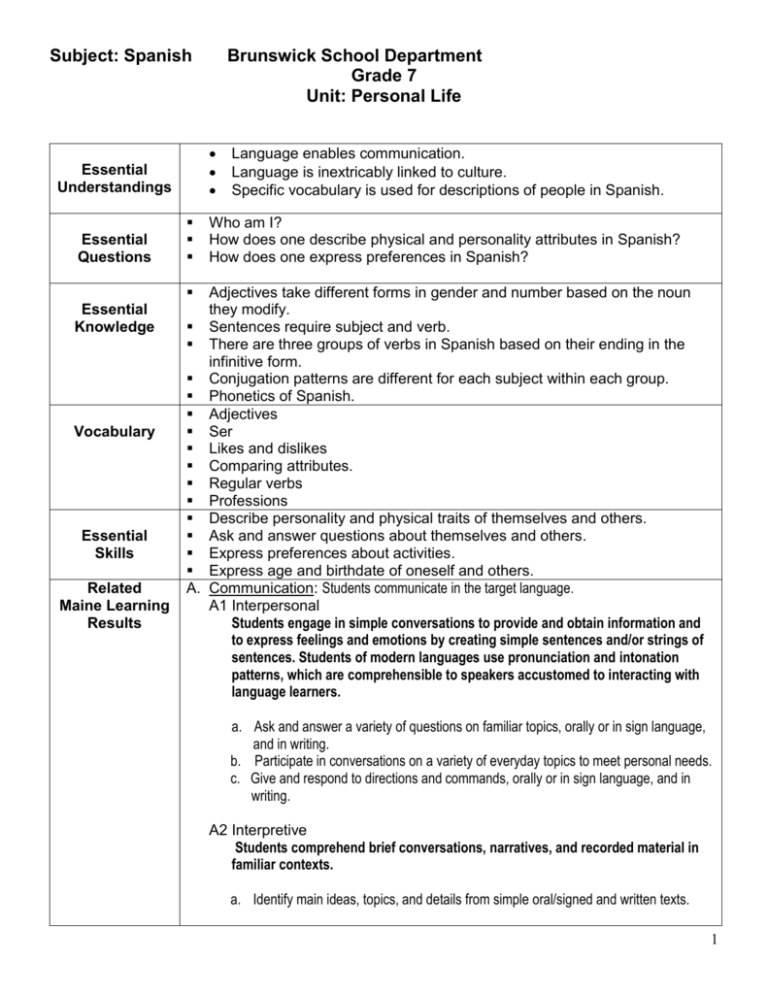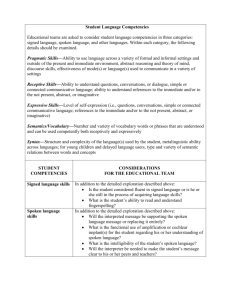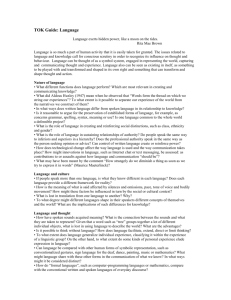Essential Understandings
advertisement

Subject: Spanish Essential Understandings Essential Questions Brunswick School Department Grade 7 Unit: Personal Life Language enables communication. Language is inextricably linked to culture. Specific vocabulary is used for descriptions of people in Spanish. Who am I? How does one describe physical and personality attributes in Spanish? How does one express preferences in Spanish? Essential Knowledge Vocabulary Essential Skills Related Maine Learning Results Adjectives take different forms in gender and number based on the noun they modify. Sentences require subject and verb. There are three groups of verbs in Spanish based on their ending in the infinitive form. Conjugation patterns are different for each subject within each group. Phonetics of Spanish. Adjectives Ser Likes and dislikes Comparing attributes. Regular verbs Professions Describe personality and physical traits of themselves and others. Ask and answer questions about themselves and others. Express preferences about activities. Express age and birthdate of oneself and others. A. Communication: Students communicate in the target language. A1 Interpersonal Students engage in simple conversations to provide and obtain information and to express feelings and emotions by creating simple sentences and/or strings of sentences. Students of modern languages use pronunciation and intonation patterns, which are comprehensible to speakers accustomed to interacting with language learners. a. Ask and answer a variety of questions on familiar topics, orally or in sign language, and in writing. b. Participate in conversations on a variety of everyday topics to meet personal needs. c. Give and respond to directions and commands, orally or in sign language, and in writing. A2 Interpretive Students comprehend brief conversations, narratives, and recorded material in familiar contexts. a. Identify main ideas, topics, and details from simple oral/signed and written texts. 1 Subject: Spanish Brunswick School Department Grade 7 Unit: Personal Life A3 Presentational Students use simple sentences and strings of simple sentences to produce short oral/signed and written presentations based on familiar topics and including a level of accuracy in form and pronunciation that could be understood by speakers accustomed to interacting with language learners. a. Write/sign messages using a prescribed, culturally-appropriate format. b. Produce and present simple creative works orally and in writing. c. Convey personal preferences or information pertaining to everyday life orally and in writing. A4 Language Comparisons Students compare the target language with English in order to better understand language systems. a. b. c. d. e. Compare basic grammatical structures and syntax between languages. Compare idiomatic expressions between languages. Compare pronunciation systems between languages. * Recognize that there are regional and/or historical variations in spoken language. Explain connections between languages through the identification of cognates. B. Cultures: Students demonstrate an understanding of a culture(s) in which the target language is spoken. B1 Practices and perspectives Students describe practices of a culture(s) and perspectives of a culture(s) in which the target language is spoken. a. b. c. Describe examples of common beliefs of a culture(s) in which the target language is spoken. Describe common attitudes of a culture(s) in which the target language is spoken. Describe common similarities and differences related to practices of a culture(s) in which the target language is spoken. B2 Products and perspectives Students identify and explain the significance of objects used in daily life, works of art, or historical artifacts that reflect the perspectives of a culture(s) in which the target language is spoken. B3 Comparisons with Own Culture Students recognize and compare perspectives related to products and practices of a culture(s) in which the target language is spoken to the cultural perspectives of the culture in which the student lives. a. Compare verbal and non-verbal communication in a culture(s) in which the target 2 Subject: Spanish Brunswick School Department Grade 7 Unit: Personal Life language is spoken to communication in the culture in which the student lives. b. Recognize contributions of a culture(s) in which the target language is spoken to life in the United States including foods, celebrations, dress, and/or architecture C. Connections: Students expand their knowledge by connecting their study of a world language(s) with other content areas. C1 Knowledge of Other Learning Results Content Areas Students apply information acquired in other Learning Results content areas to further their knowledge and skills in the target language. a. Use the writing process learned in English Language Arts when writing for the target language class. c. Apply knowledge from other Learning Results content areas including literature, social studies, science and technology, and/or the visual and performing arts to tasks in the world language classroom. C2 Distinctive Viewpoints Students locate authentic resources, available only through sources in the target language, and identify ideas about a culture(s) in which the target language is spoken. a. Locate media or other authentic sources from the target language and a culture(s) in which the target language is spoken and identify a perspective and/or practice of a culture(s) different from the students’ own viewpoints and/or behaviors. D. Communities Students encounter and use the target language both in and beyond the classroom for personal enjoyment and lifelong learning. D1 Communities Students demonstrate an understanding and use their knowledge of the target language to communicate with target language speakers, obtain information on familiar topics, and gain understanding of another culture(s). b.Identify community and online resources that can be used to gain information about the target language or associated culture(s). c. Communicate with students in the target language. d. Describe language skills and cultural insights gained through real or virtual travel. Sample Classroom Assessment Methods Sample Oral presentations. Demonstrate understanding of presentations. Continuing formative assessments through continued use of vocabulary in context. Oral and written quizzes. Teacher created materials. Authentic videos. 3 Subject: Spanish Resources Brunswick School Department Grade 7 Unit: Personal Life Games. Magazines in the target language. 4









